Paul Taylor’s American Modern Dance continues its Lincoln Center run through April 3.
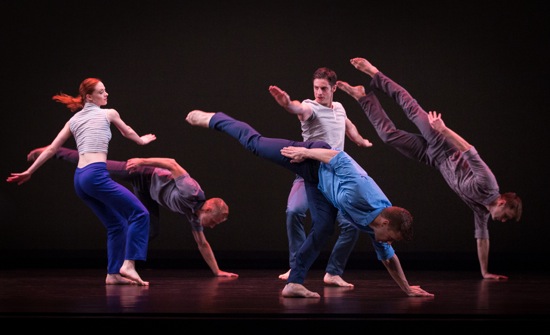
Doug Elkins’s The Weight of Smoke. Paul Taylor’s dancers (L to R): Heather McGinley, Michael Trusnovec, Michael Apuzzo, Michael Novak, and James Samson. Photo: Yi-Chun Wu
In a program essay by Susan Yung for the Paul Taylor’s American Modern Dance season (through April 3), guest choreographer Doug Elkins mentions that Taylor’s Esplanade was the first dance he ever saw on PBS’s “Dance in America” and acknowledges its influence on him. Not that you’d guess it at the opening of his The Weight of Smoke, choreographed in collaboration with the Taylor dancers (all sixteen of them). In Esplanade, no one walks lazily onto an empty stage the way Michael Novak begins Elkins’s premiere and looks around to see what’s new in the neighborhood. Justin Levine and Matt Stine’s score blasts some traffic noise and agitated voices to tell us where we are—not that these and other disruptive sounds completely overwhelm the snatches of music by Handel (an aria here, piano notes there) that later seep to the surface of the taped melée.
The Weight of Smoke builds gradually, even though from the outset the movement has a punchy vigor. And the superb performers—new to Elkins’s affiliations with hip-hop, capoeira, and his take on modern dance history—embrace his ideas with everything they’ve got (and do some things that they may have thought they’d never do onstage). No, Madelyn Ho cannot lift Michael Trusnovec, but she can give it a whirl. People saunter on at apparent random, swing their hips, ripple their arms, pal up. Eran Bugge straddles George Smallwood as he rolls; seconds later, she’s standing on one leg on his shoulder, and he carries her away. Elkins orchestrates messiness so skillfully that it’s sometimes startling how swiftly it can transform into temporary unison or counterpoint.
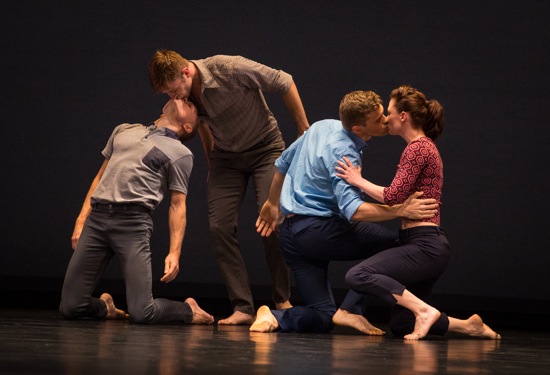
Doug Elkins’s The Weight of Smoke. L to R: Michael Trusnovec, James Samson, Michael Novak, and Eran Bugge. Photo: Yi-Chun Wu
In their smartly casual attire by Karen Young and skillfully lit by James F. Ingalls, these agile folks play against traditional gender roles and occasionally display a comradely sexuality (a hand on someone’s crotch, a quick feel of a breast). Did you ever think you’d see Novak, Smallwood, Trusnovec, Robert Kleinendorst, and James Samson swing their way toward you with a runway strut? What might seem individual and particular becomes somewhat abstracted or playfully treated. No steamy dramas arise. Partners in each of three kneeling couples simultaneously lock in a kiss and then find ways to twist, bend, or rise as they remained attached by the lips.
Elkins might almost have titled the piece Legs in the Air, so often do the dancers upend themselves on one hand or two, and there’s energetic, free-wheeling movement—the kind that makes you think of the stage as a place you’d like to visit. When The Weight of Smoke ends, it does so unceremoniously. The music just cuts out and the stage goes black.
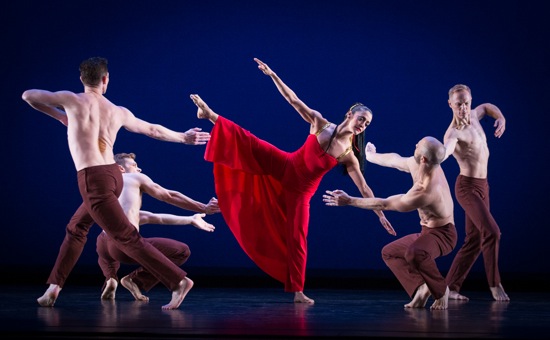
Martha Graham’s Diversion of Angels. Parisa Khobdeh surrounded by (clockwise from L.): Sean Mahoney, Michael Novak, George Smallwood, and Michael Trusnovec. Photo: Yi-Chun Wu
During the second week of the company’s season, the Taylor dancers performed a piece that’s part of Taylor’s own heritage: Martha Graham’s 1948 Diversion of Angels—one of the few from that decade in which Graham did not dance herself. Set to a made-to-order score by Norman Dello Joio (played by the Orchestra of St. Luke’s, led by Donald York) and with lighting by Jennifer Tipton (after Jean Rosenthal’s original designs), it might be taking place in an Elysian field instead of on a New York stage. During his seven seasons dancing with Graham’s company, Taylor was one of the four men in Diversion of Angels who leap and cartwheel and celebrate love. Three of these and their partners represent the phases of that love. The woman in yellow is a young girl—vivacious and playful, adoring to be swung through the air. The woman in red is more sensual, more in thrall to passion. The woman in white has reached a kind of serenity that still has room for questioning.
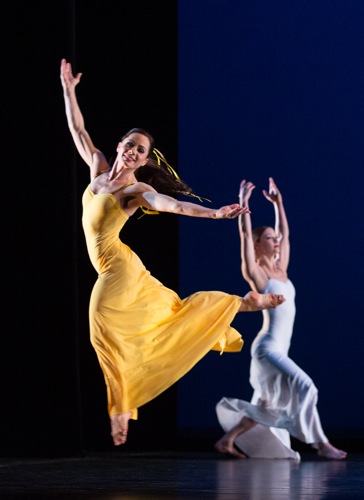
Eran Bugge (L) and Laura Halzack in Martha Graham’s Diversion of Angels. Photo: Yi-Chun Wu
Diversion of Angels is one of those perfect pieces—clear, beautifully designed, and full of life and feeling. It was reconstructed by current Graham dancers Blakely White-McGuire and Tadej Brdnik and coached by Linda Hodes, a Graham company member of an earlier generation, and the Taylor dancers perform it with rapturous vitality. Bugge and Novak are the spirited youngest partners, Parisa Khobdeh and Mahoney the passionate ones, and Laura Halzack and Trusnovec the reserved, tender elders. Michelle Fleet, Jamie Rae Walker, Heather McGinley, Christina Lynch-Markham, and Smallwood complete the cast.
A couple of small discrepancies struck me. At times Halzack eases into movements that are embedded in my memory as all-at-once ones. And Khobdeh, a vivid streak of red as she races across the space and a tempest in one solo, performs the famous progress across the front of the stage as if she’d never heard of a Graham “contraction.” The choreography has her repeatedly stepping sideways onto one leg, the other leg held high to the side and her body tilted away from it. Usually that too has been performed as a single, breath-caught move, sometimes followed by a deep contraction, as if the wind had been knocked out of her by her own exaltation. Each time Khobdeh performs this step, she hits the pose and then bends a bit further to the side, giving the step a yielding, almost sentimental look.
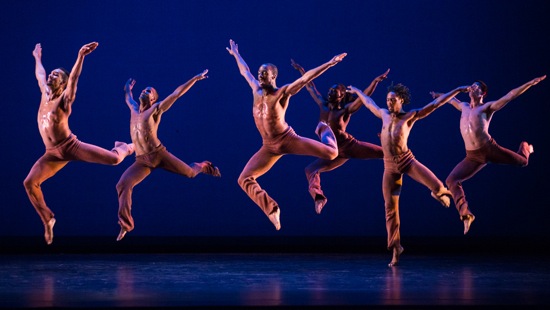
Dayton Contemporary Dance Company in Donald McKayle’s Rainbow ‘Round My Shoulder. L to R, front row: Demetrius Tabron, Joshua Ishmon, Quentin A. V. Sledge. L to R, back row: Alvin Rangel, Devin Baker, Robert Pulido. Photo: Yi-Chun Wu
The other dance by a guest choreographer this season is Donald McKayle’s 1959 Rainbow ’Round My Shoulder, but although Taylor’s company has the seven strong male dancers the piece requires, they might not get through the rest of the program after performing it. The accomplished men in the guesting Dayton Contemporary Dance Company are streaming with sweat by the time they’ve finished the heavy, forceful blows that toiling in a chain-gang requires. They also jump over and over (although the piece feels a bit long, that length rams home the arduousness of these men’s lives). The men (Devin Baker, Michael Green, Joshua L. Ishmon, Robert Pulido, Alvin Rangel, Quentin Apollo Vaughn Sledge, and Demetrius Tabron) do get a chance to rest or react emotionally to the visions conjured up of the women they’ve left behind. Alexis Britford (excellent) appears as a remembered sweetheart, then as a mother, then a wife. A flower in her hair or a scarf tied over it helps signal that she will tempt, nurture, or support a dreaming man (Sledge and Green are the two soloists). Destan Owans, with Michael McElroy and the Broadway Inspirational Voices, plus guitarist Gary Sieger perform from the pit the fine old songs collected by the Allen and John Lomax and arranged by Robert DeCormier and Milton Okun.
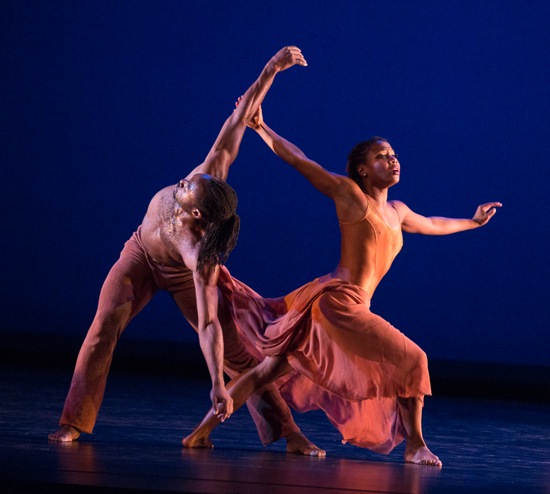
Michael Green and Alexis Britford of Dayton Contemporary Dance Company in Donald McKayle’s Rainbow ‘Round My Shoulder. Photo: Yi-Chun Wu
Not all the Taylor works on the programs that I saw are masterpieces. But although Snow White (1983) and Three Dubious Memories (2010) are slight works, the choreographer gives deft comedic twists to plots we know. Snow White’s dwarfs (only five: Kleinendorst, Samson, Francisco Graciano, Michael Apuzzo, and Smallwood) are marvels at clumping round, walking in a squat, capering acrobatically, and hinting at their various characters as per the fairytale seven. But the charmingly playful Snow White (Khobdeh) ends up finding her reflection in the mirror much more absorbing than the strutting, nose-in-the-air Prince (Sean Mahoney) who’s carrying her off. Mahoney also plays the evil, mirror-obsessed Queen, and Heather McGinley twitches around as her poison-laced Apple. All to York’s specially composed score.
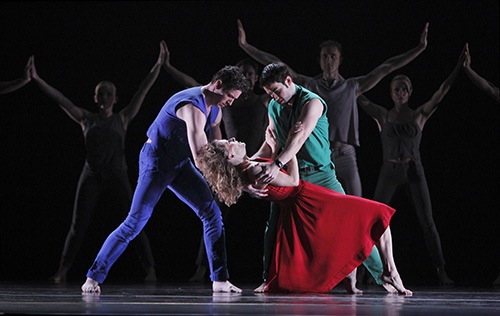
Paul Taylor’s Three Dubious Memories. Sean Mahoney (L) and Robert Kleinendorst manhandle Amy Young (in an earlier cast). Photo: Paul B. Goode
Three Dubious Memories brings to mind the 1950 film Rashomon, which was in turn based on a Japanese short story. What fun there is in Taylor’s dance, set to Peter Elyakin’s intriguing Five Enigmas (four sections only and heard on tape) comes from seeing how each of two men and a woman tells a different version of a love-and jealousy encounter in the forest before a mysterious group of seven billed as Choristers, with Samson as the Choirmaster. Perhaps he is the judge and they the jury that can’t decide which of the three is telling the truth. about his/her encounter. The twist is that after the Man in Blue (Mahoney) “remembers” coming upon the Woman in Red (Bugge) and the Man in Green (Kleinendorst) nestled together, and “Green” rages at the sight of “Blue” and “Red” romancing, the men have a guys-only adventure, and the woman wallops them both. The Choristers reach no conclusion, and the three squabble themselves into an exhausted heap.
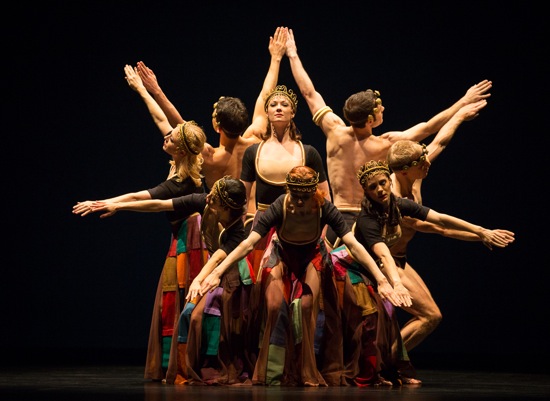
Paul Taylor’s Images. Laura Halzack center and, clockwise from center front: Heather McGinley, Madelyn Ho, Jamie Rae Walker, Francisco Graciano, Robert Kleinendorst, Michael Trusnovec, and Eran Bugge. Photo: Yi-Chun Wu
Taylor delved into antiquity for the lovely, small-scale Images (1977) and Profiles (1979). For the first, Gene Moore costumed the eight dancers like Cretan athletes and maidens (originally, the women’s breasts were covered by flesh-colored net, but as the result of a last-minute decision this season, they were bare), and the accompaniment is delicate piano pieces by Claude Debussy, played by Margaret Kampmeier. Sometimes, in sections with names such as “Totem Dolphins” and “Antique Cortege,” the performers fit into patterns as controlled and two-dimensional as processions on a painted vase, but they also frolic. In the central solo, “Oracle,” Halzack—covering her mouth, her eyes; snaking her arms; tossing her head from side to side—indeed seem to be dragging difficult visions into the small circle of light in which she stands.
In Profiles, to a commissioned score for string quartet by Jan Radzynski, four dancers (Trusnovec, Halzack, Bugge, and Novak) enact what might be the fragments of a lost story. The music sometimes buzzes around them like a swarm of bees or contradicts their composure with drastic imagery. Sometimes one pair freezes in a pose while the other moves. Positions that could be two-dimensional flower into three dimensions when the dancers rotate them.
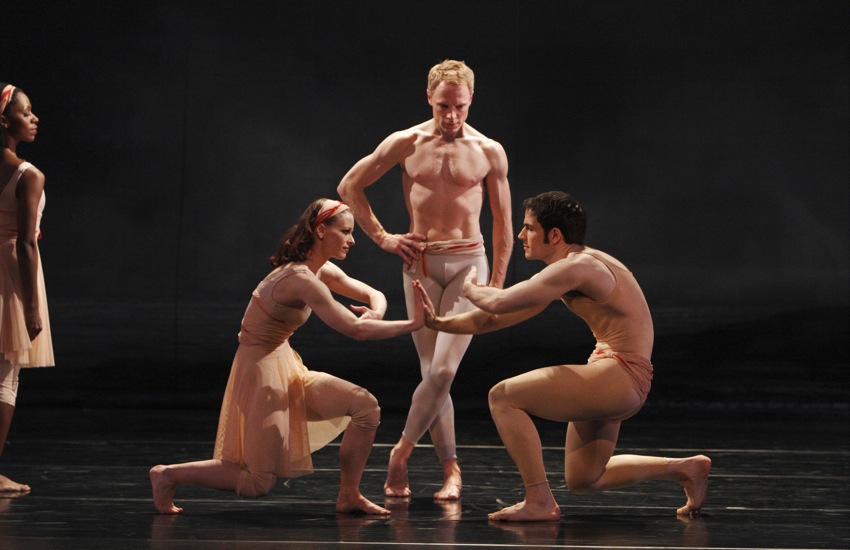
An earlier image of Paul Taylor’s Spindrift. L to R: Michelle Fleet. Anna-Marie Mazzini, Michael Trusnovec, and Robert Kleinendorst. Photo: Paul B. Goode
I can’t recall ever seeing the 1993 Spindrift, and I’d like to see this enigmatic work again. It’s set to Arnold Schoenberg’s haunting 1933 Concerto for String Quartet (after Händel’s Concerto Grosso, Op. 6, No. 7). Donald York conducted Kristi Bennion Feeney and Anca Nicolau (violins), David Cerutti (viola), and Myron Lutzke (cello). “Spindrift” refers to the ocean spray stirred up by wind, and Santo Loquasto’s handsome backdrop by conjures up in the most mysterious and romantic way a glowing red sky, a sea, and a strand. Initially, this design is a smallish rectangle on a blank surface; later, it fills that space.
Initially the eleven clustered dancers too suggest waves and ripples within a larger undulation—two women stepping out of the group and receding back into it, then four men, and so on. Trusnovec seems to be a man apart. He falls a two or more couple of times. You think the dance could involve an initiation; he others create a tunnel of their legs and he scrabbles the way through it. Or is it an oblique drama about a man trying to fit into a playful group—a kind of Robinson Crusoe cast ashore? All the shifting interactions emerge within an ongoing rush of dancing, which eventually he joins—one of them. Nevertheless, he ends almost alone; Ho, on the opposite side of the stage backs away. He raises an arm toward her in a curious gesture that recurs throughout Spindrift; it’s like a summons or even a “hail.” The lights go out.
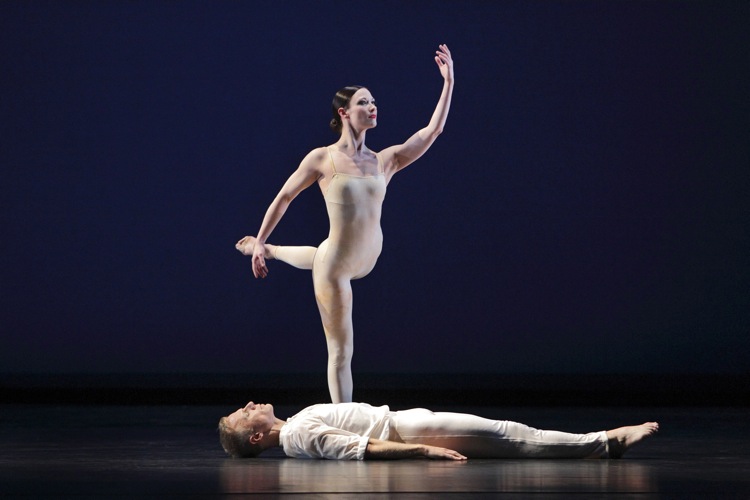
Laura Halzack and Michael Trusnovec in Paul Taylor’s Beloved Renegade. Photo: Paul B. Goode
Trusnovec is as fine now as he was in 2008 as the central figure in Taylor’s Beloved Renegade—perhaps even finer. This great work and the quotes from Walt Whitman’ Leaves of Grass that introduce its sections allude to the poet’s work as a battlefield doctor during the Civil War, and Taylor builds images of wounded and dying soldiers, children playing games, a man and woman in love (Khobdeh and Kleinendorst), a woman who reaches out to the hero (Christina Lynch Markham), and another, Halzack, as (perhaps) his muse. Francis Poulenc’s Gloria—conducted by York and performed by the Orchestra of St. Luke’s and the St. George Choral Society—underscores and bears the weight of Whitman’s and Taylor’s themes: love, sensual awakening, sacrifice, and death.
I don’t know how the Taylor dancers have been appearing to spectators in the second or third ring of the former New York State Theater. From my fortunate orchestra seat, I’ve been relishing the gusto with which they attack the jubilant steps, the grave simplicity with which they perform the quieter passages, and the mischief that they bring to comedy. It’s also a pleasure to watch them grow into Taylor’s style. In 2014, it was Francisco Graciano who suddenly seemed to own the steps he was performing. In 2016, Novak, McGinley, and Lynch Markham come across more vividly. But as important as the physical skills they all possess is the way that they see— really see—and respond to one another. My eye goes, say, to Samson offering his hand to a partner so they can run offstage together. He doesn’t just take her hand; through his focus and a slight inclination, he asks her permission (“want to come with me?”). And, for the most part, everyone delineates those subtle aspects of group behavior. Watch the always terrific Kleinendorst, the last (I believe) to touch the shoulder of the dancer beside him in that tight sinking-down circle in Esplanade; he doesn’t embellish or exaggerate the gesture, but makes you feel its firm, yet gentle pressure. Maybe Michelle Fleet goes a little overboard in her first solo bit in that dance, but it’s rare for her—or any of them—to court the audience (unless that’s the point). And it’s through that onstage camaraderie , those small details, and their investment in the moment that they illumine Taylor’s choreography—making his lesser works gleam and his great ones light up the theater.
